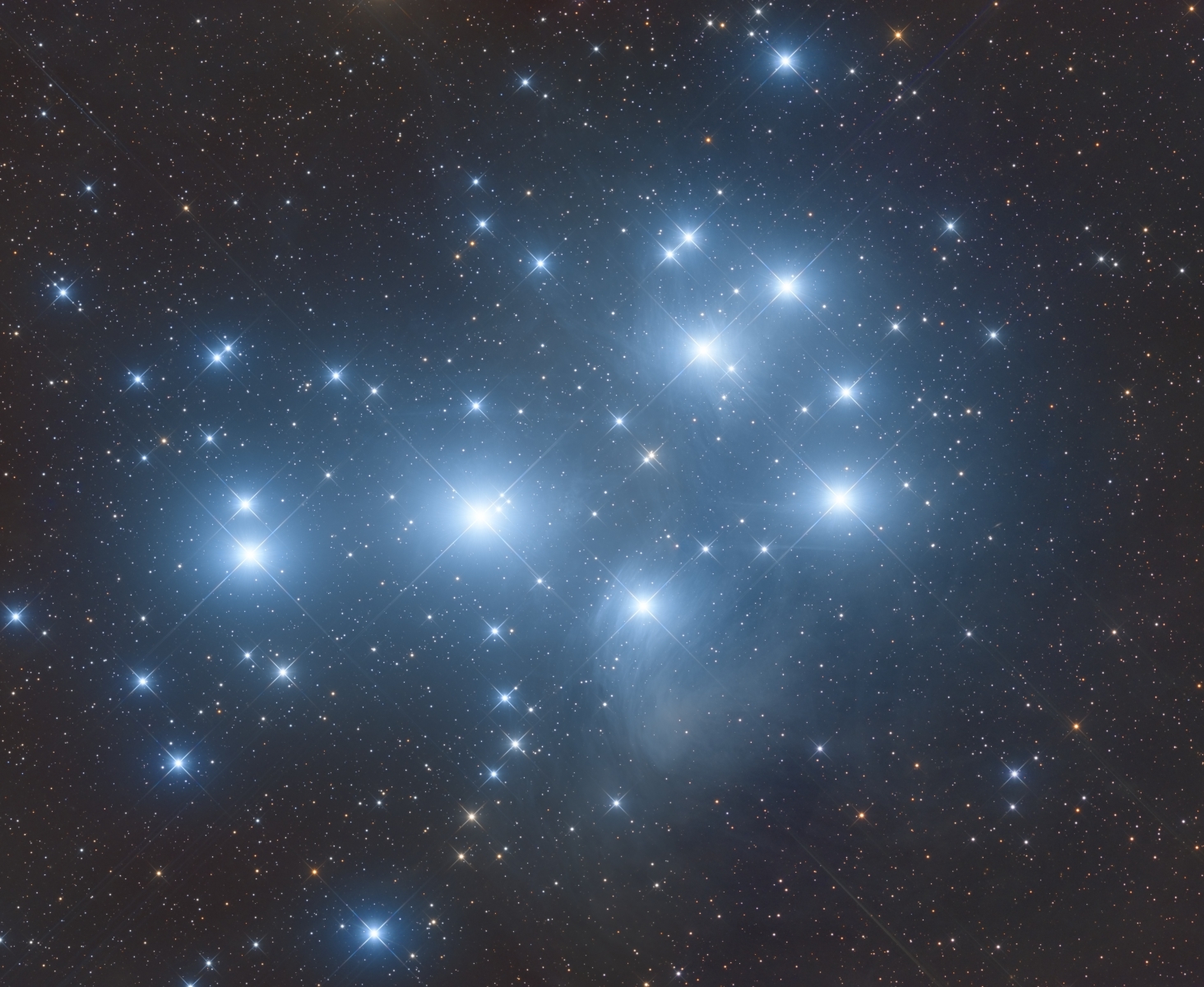M45, The Pleiades
 Click image for full size version
Click image for full size version
October 21, 2016
The attached image shows M45, better known as the Pleiades, or the Seven Sisters. In Latin America, it’s called “the Seven Kids”, as in baby goats). The Pleiades was observed and written about long before Messier catalogued it. Galileo published a sketch in 1610 that showed 36 stars that he could see with his telescope. The earliest known depiction of the Pleiades is from is about 17,000 years old: a cave drawing in the Lascaux Cave in France. If you get a chance, have a look at this object through binoculars. It is spectacular and well placed high in the eastern sky at dusk this time of year.
The blue haze around this star cluster is a reflection nebula – star light is being reflected of soot/dust particles in the background. There’s also some pinkish emission nebula in the central lower portion of the nebula and dim brownish dust mottling the outer parts of this field (called “cirrus”).
 Although the Pleiades is the dominant object in this shot, there are also hundreds of galaxies visible. I have posted an annotated image that highlights the location of some of them. I encourage you to load the image and zoom in on the highlighted areas to see the many faint fuzzies.
Although the Pleiades is the dominant object in this shot, there are also hundreds of galaxies visible. I have posted an annotated image that highlights the location of some of them. I encourage you to load the image and zoom in on the highlighted areas to see the many faint fuzzies.
M45 is about 440 light years from us and contains at least 1000 members in the cluster. The stars have been estimated to be between 75 and 150 million years old. The brightest cluster stars belong to class B, and are very hot bluish stars. The galaxies in the field are much further away, up to hundreds of millions of light years.
Tekkies
Moravian G3-16200 EC camera (on loan from O’Telescope), Optolong RGB filters, 10″ f/3.6 ASA astrograph, Paramount MX, QHY5 guide camera through Lumicon 500 mm f.l. achromat. Acquisition with the SkyX, Focusing with FocusMax. All pre-processing and processing in PixInsight. Acquired from my SkyShed in Guelph. Nearly full moon, no cloud, average transparency and average seeing.
Mosaic Pane 1: 25x5m R, 25x5m G and 21x5m B unbinned frames
Mosaic Pane 2: 27x5m R, 24x5m G and 24x5m B unbinned frames
Total exposure time 12hr10m
Mosaic Creation
R, G and B masters for both frames were cropped to remove edge artifacts and processed separately with DBE. ImageRegistration was used in mosaic/union mode to make a mosaic template from the blue image of Pane 1 and Pane 2. ImageIntegration was used to align each channel of each pane to the template. GradientMergeMosaic was used to merge Pane 1 and Pane 2 of each channel, to give three master images (R, G and B). Edge artifacts were cropped.
RGB
Creation and cleanup: R, G and B masters were combined to make an RGB image which was processed with DBE and ColorCalibration.
Linear Noise Reduction: MultiscaleLinearTransform was used to reduce noise in the background areas. Layer settings for threshold and strength: Layer 1: 3.0, 0.5 Layer 2: 2.0, 0.35 Layer 3: 1.0, 0.2 Layer 4: 0.5, 0.1
Stretching: HistogramTransformation was applied to make a pleasing yet bright image. TGVDenoise was applied and the image was re-stretched to reset the black point.
Synthetic Luminance:
Creation and cleanup of SynthL: The R,G and B masters were combined using the ImageIntegration tool (average, additive with scaling, noise evaluation, iterative K-sigma / biweight midvariance, no pixel rejection). DBE was applied.
Deconvolution: A star mask was made to use as a local deringing support. A copy of the image was stretched to use as a range mask. Deconvolution was applied (50 iterations, regularized Richardson-Lucy, external PSF made using DynamicPSF tool with about 25 stars).
Linear Noise Reduction: MultiscaleLinearTransform was applied to reduce the noise. Layer settings for threshold and strength: Layer 1: 3.0, 0.5 Layer 2: 2.0, 0.35 Layer 3: 1.0, 0.2 Layer 4: 0.5, 0.1
Stretching: HistogramTransformation was applied to make a pleasing yet bright image. TGVDenoise was applied and the image was re-stretched to reset the black point.
Combining SynthL with RGB:
The luminance channel of the RGB image was extracted, processed and then added back into the RGB image as follows:
1. Extract luminance from the RGB image.
2. Apply LinearFit using SynthL as the reference.
3. Use ChannelCombination in Lab mode to replace the RGB’s luminance with the fitted luminance from step 2.
4. LRGBCombine was then used to make a SynthLRGB image.
Final Processing of SynthLRGB:
The bright portions of the nebula were slightly sharpened with MultiscaleLinearTransform (bias +0.05 for layer 2 and 3 and bias +0.02 for layer 4).Background and star brightness, contrast and saturation were adjusted in several iterations using Curves with masks as required.
Image scale is 1.36 arcsec per pixel for this camera / telescope combination.






Hi Ron,
That’s an amazing image, love the star colours too!
Amazing what you get with so
much exposure time. I have an image of this object on my website, now I want to try and zoom in and see if I can say any of those galaxies 😃 Thanks for sharing. I’m starting to get back into imaging with my home made driven mount – and your post is inspiring, take a look at my website and see what you think
http://www.astronomyblogger.com
Cheers
Matt
Thank you for posting this most interesting and educational pictorial series of shots along with the editorial.